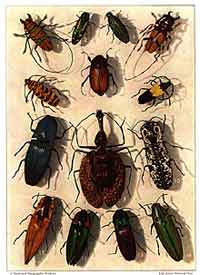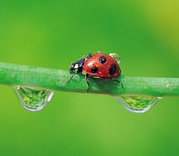|
Beetles are one of the most diverse groups of insects. Their order, Coleoptera (meaning "sheathed wing"), has more described species in it than in any other order in the animal kingdom. Forty percent of all described insect species are beetles (about 350,000 species), and new species are regularly discovered. Estimates put the total number of species, described and undescribed, at between 5 and 8 million. This is why when J. B. S. Haldane, a Scottish geneticist, was asked what his studies of nature revealed about God, he replied, "An inordinate fondness for beetles".
|
|

 Variety: Beetles entered the fossil record during the Lower Permian, about 265 million years ago. The large number of beetle species poses special problems for classification, with some families consisting of thousands of species and needing further division into subfamilies and tribes. Variety: Beetles entered the fossil record during the Lower Permian, about 265 million years ago. The large number of beetle species poses special problems for classification, with some families consisting of thousands of species and needing further division into subfamilies and tribes.
Anatomy: The general anatomy of beetles is quite uniform, though specific organs and appendages may vary greatly in appearance and function between the many families in the order. Beetle bodies are divided into three sections: the head, the thorax, and the abdomen. Like all insects, beetles are segmented organisms, and all three of the major sections of the body may themselves be composed of several further segments, although these are not always readily discernable.
Armor: Beetles are generally characterised by a particularly hard exoskeleton and hard forewings (elytra). The beetle's exoskeleton is made up of numerous plates called sclerites, separated by thin sutures. This design creates the armoured defences of the beetle while maintaining flexibility. The elytra are not used for flight, but tend to cover the hind part of the body and protect the second pair of wings (alae). Elytra must generally be raised in order to move the hind flight wings. A beetle's flight wings are crossed with veins and, after landing, are folded, often along these veins, and stored below the elytra. In some cases the ability to fly has been lost, most notably in the ground beetles (family Carabidae) and the true weevils (family Curculionidae), but also in some desert and cave-dwelling species of other families.
Shape shifters: Beetles are endopterygotes with complete metamorphosis.The larva of a beetle is called a grub, and often represents the principal feeding stage of the life-cycle. Larvae tend to feed voraciously once they emerge from their eggs. Some feed externally on plants, such as those of certain leaf beetles and lady bird beetles, while others feed within their food sources. The larval period varies between species but can be as long as several years. All beetle larvae go through several instars, which are the developmental stages between each moult. In many species the larvae simply increase in size with each successive instar.
As with all endopterygotes insects, beetle larvae pupate for a period of time, and from the pupa emerges a fully formed, sexually mature adult beetle, or imago. Adults have an extremely variable lifespan, from weeks to years, depending on the species.

 Many places for Beetles to live: Beetles can be found in almost all habitats, but are not known to occur in the sea or in the polar regions. They impact the ecosystem in several ways. Many places for Beetles to live: Beetles can be found in almost all habitats, but are not known to occur in the sea or in the polar regions. They impact the ecosystem in several ways.
Damage: On the one hand, they feed on plants and fungi, breaking down animal and plant debris, and eating other invertebrates. On the other hand they are prey of various animals including birds and mammals. Certain species are agricultural pests, such as the the red flour beetle Tribolium castaneum, the Colorado potato beetle Leptinotarsa decemlineata, or the mungbean beetle Callosobruchus maculatus Fabr. while others are important controls of agricultural pests. For example , lady beetles (family Coccinellidae) consume aphids, fruit flies, thrips, and other plant-sucking insects that damage crops. , lady beetles (family Coccinellidae) consume aphids, fruit flies, thrips, and other plant-sucking insects that damage crops.
Defense: Beetles and their larvae have a variety of strategies to avoid being eaten, for example using camouflage to avoid being spotted by predators. These include the leaf beetles (family Chysomelidae) that have a green colouring very similar to their habitat on tree leaves. More complex camouflage also occurs, as with some weevils (family Curculionidae), where various coloured scales or hairs cause the beetle to resemble bird dung.
Sacred to some: Several species of the dung beetles, most notably Scarabaeus sacer (often referred to as "scarab"), enjoyed a sacred status among the ancient Egyptians, as the creatures were likened to the god Khepri. Some scholars suggest that the people's practice of making mummies was inspired by the brooding process of the beetle.
All text is available under the terms
of the GNU Free Documentation License
|